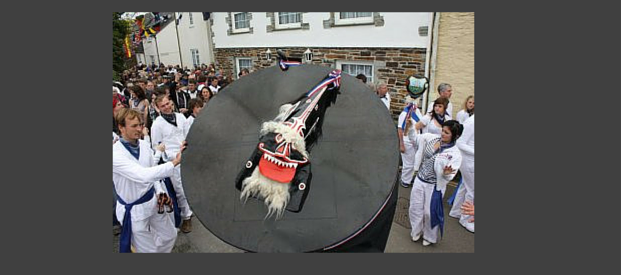Why May Day is More Than Just a Day Off Work
 It’s the much loved May Day bank holiday today – 4th May. It seems like such a European custom – associated as it is in this country with Morris dancing, maypoles and village fêtes – but May Day is actually celebrated all around the world. This is mainly because it holds its origins with International Workers’ Day – even places like the US, where there is no link to ancient Spring customs, traditionally celebrate on May Day for this reason. In fact, there’s a lot more to May Day than most people think.
It’s the much loved May Day bank holiday today – 4th May. It seems like such a European custom – associated as it is in this country with Morris dancing, maypoles and village fêtes – but May Day is actually celebrated all around the world. This is mainly because it holds its origins with International Workers’ Day – even places like the US, where there is no link to ancient Spring customs, traditionally celebrate on May Day for this reason. In fact, there’s a lot more to May Day than most people think.
At Rose Calendars, we’re all in agreement that May Day is one of the best public holidays of the year. Yet, we do think it’s a shame that so few people are aware of its origins and its importance to workers even today. It’s ironic, because a national holiday like May Day would be unthinkable without a movement like International Workers Day. On May 4th, whilst you’re enjoying the bank holiday, just take a minute to wonder at the fact that European May Day celebrations are thought to date back to the ninth century – or that May Day is celebrated in eighty countries. It’s more than just a day off work, so here are some interesting facts that you probably don’t know about May Day.
Dancing Around The Maypole
One of the most famous May Day customs is the maypole dance, in Great Britain especially. It’s a curious tradition that dates back to the Middle Ages, when fair young maidens would simultaneously dance around and decorate a tall wooden pole. Whilst almost every British person has seen a maypole dance, in some form or another, it’s a tradition that is slowly becoming obsolete. To the surprise of most, similar rituals are actually practised throughout various parts of Latin America.
Fertility Flourishes
It doesn’t take a genius to work out what the maypole itself is designed to represent. As the entire May Day tradition has always been wrapped up with Pagan and Celtic fertility rituals, at least in Britain, it should come as no surprise to find that the maypole is believed to be a phallic symbol. The colourful flowers, wreaths and ribbons used to garland it are thought to represent the feminine. There are some controversial scholars, however, who are keen to point out that the maypole is a nod to the sacred nature of the trees.
Another explanation of the maypole, is that it represents the end of winter, when a pole or tree trunk was driven into the ground, and ribbons and flowers were used to decorate the pole as a sign of spring, and to signify a beginning to the planting of crops and growing of plants. The tallest maypole was erected in London in 1661 on the Strand, where it stood over 143 feet high. It was felled in 1717 when it was used by Sir Isaac Newton to support Huygen’s new reflecting telescope.
A Working Celebration
As far as important dates in history go, you can’t get much more significant than May 4th, 1886. It’s certainly a date that most lifelong socialists are well aware of, even if it’s not always marked on their calendars. In essence, International Workers’ Day is the commemoration of this date – it remembers the Haymarket affair, in Chicago, when police opened fire on strikers protesting on behalf of the eight hour workday. It wasn’t until 1891 that the date was recognised as a day of international demonstration and protest, but after this point the working classes of many different countries sought to make it a public holiday. As you can see, many of them succeeded.
Distress Signal
Contrary to popular belief, the international distress signal ‘May-day, May-day, May-day’ has nothing to do with May Day. Whilst it might sound like the words ‘May Day’ are being spoken, it’s actually French for ‘Help Me’ – the correct phrase is “M’aider”. The call should always be given three times in a row, to make sure that it isn’t mistaken for anything else under noisy conditions.
 A Field Day
A Field Day
Due to the close links between May Day and the abundant fertility of Spring, lots of people believed that it was the best time to procreate. It was even thought that going for a romp in the fields would actively help the crops to grow stronger and faster. It should come as no surprise to find that most people didn’t need too much encouragement to sneak off for a ‘roll in the hay’. This wilful libidinousness wasn’t popular with everybody, however and the Catholic Church banned May Day celebrations during the early 1600s. In 1664, a tamer version of May Day was revived by Charles II.
Strange Customs
There are hundreds, if not thousands, of strange and unexplained beliefs associated with the May Day holiday. According to some, it’s a chance for fairies and nature spirits to travel to the Earth and there’s also a very old tradition that once saw scores of young women washing their face in the dew from May Day morning. According to legend, it’s supposed to greatly beautify the skin. In Italy, May Day is thought to be the happiest day of the year. It used to be that in Britain, children would try to leave small baskets of sweets and flowers on doorsteps without being seen.
 One of the largest events held in the UK is in Padstow in Cornwall, called the ‘Obby ‘Oss Day, where thousands of revellers gather in the town. The origins of the celebrations are unclear, but a fearsome mask of regalia is set into a body covering costume built around a six feet wide circular wooden hoop. It is carried on the wearer’s shoulders using internal straps and covered in sailcloth draping to the ground. The wearer then proceeds through the streets of Padstow, swirling and dancing, accompanied by a ‘Teazer’ who leads the dance with a Teazer’s club – a colourfully decorated leather pad mounted on the end of a wooden rod. The accompanying dancers are dressed in white and decorated with ribbons, cowslips and bluebells, joined by musicians and drummers, and followers who sing a traditional May Song.
One of the largest events held in the UK is in Padstow in Cornwall, called the ‘Obby ‘Oss Day, where thousands of revellers gather in the town. The origins of the celebrations are unclear, but a fearsome mask of regalia is set into a body covering costume built around a six feet wide circular wooden hoop. It is carried on the wearer’s shoulders using internal straps and covered in sailcloth draping to the ground. The wearer then proceeds through the streets of Padstow, swirling and dancing, accompanied by a ‘Teazer’ who leads the dance with a Teazer’s club – a colourfully decorated leather pad mounted on the end of a wooden rod. The accompanying dancers are dressed in white and decorated with ribbons, cowslips and bluebells, joined by musicians and drummers, and followers who sing a traditional May Song.
Happy May Day everyone! And for anyone feeling rather ‘Starwarsy’ – “May The Forth Be With You!”









